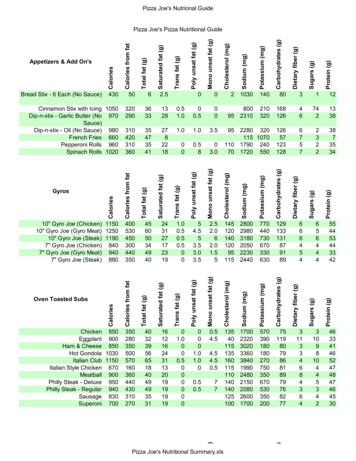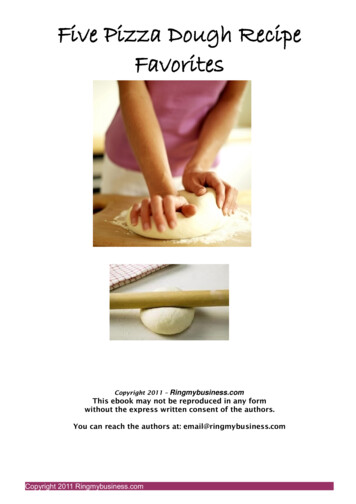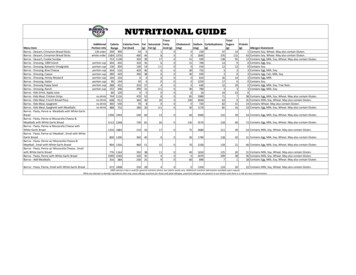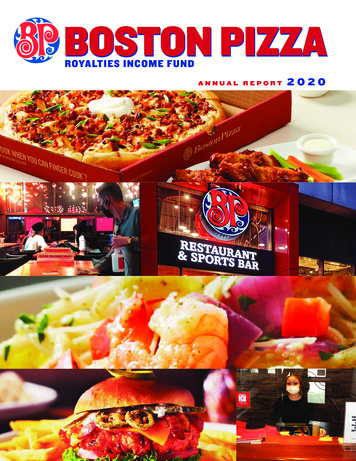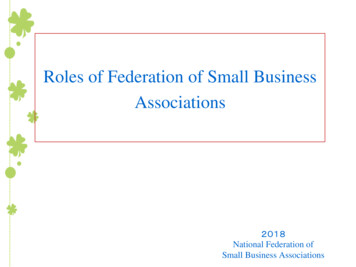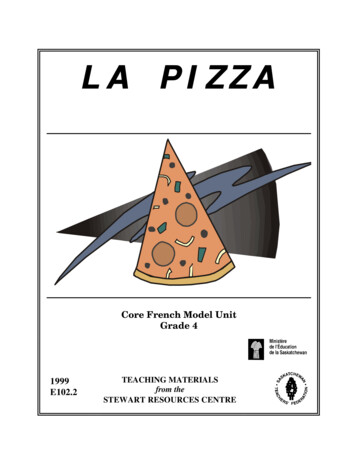
Transcription
LA PIZZACore French Model UnitGrade 41999E102.2TEACHING MATERIALSfrom theSTEWART RESOURCES CENTRE
Table de matièresPageSuggested vocabulary.1.2.3.4.5.6.7.8.9.10.11.6Discuss favorite pizzas .Discuss the experiential goal and the possible steps to achieve the goal.Become familiar with the different kinds of pizza .Determine family preferences.Become familiar with different toppings for pizza .Become familiar with pizza menus .Become familiar with pizza recipes.Create a pizza recipe and present it to the class.Design an invitation and order form .Plan and prepare for a pizza party.Reflect on the unit .778910111214141515Annexes1 Quelle sorte de pizza est-ce que tu aimes ? .2 Quelle sorte de pizza est-ce que ta famille aime ? .3 La phrase secrète .4 Questions .5 Choisis une garniture .6 Une pizza.7 La pizza .8 Les pizzas extraordinaires .9 Commande une pizza au téléphone .10 La pizza super.11 Ma pizza favorite.12 L’évaluation des recettes.13 Le party des pizzas .14 L’auto-évaluation du Party des pizzas.15 L’auto-évaluation de cette unité .16 Auto-évaluation.17 Participation orale .18 Participation de l’élève .19 Clipart esources.List of Distributors .46481
Guide
Field of experience:FoodTopic to be developed:PizzaExperiential goal:Students will plan and preparefor a pizza party.Learning ObjectivesThe students will: participate in a variety of languageactivities on the topic of pizza identify different types of pizza discuss the various pizza toppings discuss different pizza menus create and present a pizza recipe work together to plan and prepare a pizzaparty strive for more accurate and effective useof linguistic structures demonstrate a positive attitude towardssecond language learningThe following vocabulary and linguisticcontent is included throughout the unit. Theteacher and students should decide whatelements will be included in the experientialgoal. learning vocabulary about pizza determining what kinds of pizza thestudents prefer identifying what kinds of pizza thestudents’ family members prefer learning how to order a pizza off a menu learning how to read and create a pizzarecipe planning a pizza partySuggested Steps6.Become familiar with pizza menus.1.Discuss favorite pizzas.7.Become familiar with pizza recipes.2.Discuss the experiential goal and thepossible steps to achieve the goal.8.Create a pizza recipe and present it tothe class.3.Become familiar with the different kindsof pizzas.9.Design an invitation and order form.4.Determine family preferences5.Become familiar with the differenttoppings for pizzas.10. Plan and prepare for a pizza party.11. Reflect on the unit.This unit was developed following the curriculum guidelines by:Valerie Choo-Foo, teacherMoose Jaw School Division No. 1The Experiential Goal5
Suggested VocabularyLa pizzaun party – partyun party de pizzas – pizza partydes garnitures (f) – toppingsune pizza simple – plain pizzaune pizza de luxe – deluxe pizzaune pizza hawaïenne – Hawaiian pizzaune pizza mexicaine – Mexican pizzaune pizza végétarienne – vegetarian pizzaune pizza aux fruits de mer – seafood pizzade l’ ananas – pineappledes anchois (m) – anchoviesdu bacon – bacondu bœuf – beefdu bœuf haché – ground beefdes champignons (m) – mushroomsdes crevettes (f) – shrimpdes olives (noires/vertes) (f) – olives(black/green)des tomates (f) – tomatoesde la sauce tomate – tomato saucedu fromage – cheesedu jambon – hamdes poivrons (verts/rouges) (m) – peppers(green/red)un piment rouge – chili pepperdu pepperoni – pepperonides oignons (m) – onionsde la saucisse – sausagede la saucisse italienne – Italien sausagedes épices (f) – spicesde la pâte – doughde la croûte – crustLes boissonsune boisson gazeuse – popdu lait – milkdu jus– juicede l’eau – waterdu thé – teadu café – coffeedu chocolat chaud – hot chocolatdu lait frappé – milkshake6Les saladesde la salade césar – ceasar saladde la salade verte – green saladde la salade grecque – greek saladde la salade du chef – chef’s saladLes dessertsla crème glacée (à la vanille, au chocolat, auxfraises) – ice cream (vanilla, chocolate,strawberry)le gâteau au chocolat – chocolate cakeune tarte aux pommes – apple piedes fruits (m) – fruitLes adjectifsle meilleur, la meilleure – bestdélicieux, délicieuse – deliciousfrais, fraîche – freshpiquant(e), épicée – spicysalé(e) – saltygratuit(e) – freeLes verbesaimer – to likeadorer – to lovedétester – to hatecommander – to orderfaire la cuisine – to cookgoûter – to tasteajouter – to addchauffer – to heatcouper – to cutétaler – to spreadattendre – to waitmettre – to putpréparer – to preparemélanger – to mixfaire – to makeLes expressionsj’ai besoin de – I needbeaucoup de – a lot ofJ’ai faim – I’m hungry
Field of experience:FoodTopic to be developed:PizzaExperiential goal:party.Students will plan and prepare for a pizzaSUGGESTED STEPS:1. DISCUSS FAVORITE PIZZAS.Teaching NotesACTIVITIES1.1 Brainstorm what kinds of pizza the students like.1.2 Bring a pizza box to class that has some pictures of thedifferent kinds of pizzas inside and see if the studentscan guess the French words for the types ofpizzas ortoppings for pizzas. This will make the teacher aware ofthe students’ knowledge on this topic. Label the picturesand put them up in the classroom as references.1.3 Students could make their own pizzas out of modelingclay.1.4 Supplementary Activity: Play the song «Je suis unepizza» by Charlotte Diamond, and have the studentswrite down as many words as they can that theyunderstand. The teacher may need to play it a fewtimes. At the end of the song, the teacher drops a pizzabox on the floor so that all the parts of a pretend pizza fallout. The pretend pizza may be made out of modeling clay orpaper.1.5 Supplementary Resource:«J’adore la pizza !» Images2. DISCUSS THE EXPERIENTIAL GOAL AND THEPOSSIBLE STEPS TO ACHIEVE THE GOAL.ACTIVITIES2.1 Discuss possible scenarios of holding a pizza party.Brainstorm all the necessary items required to hold thepizza party – invitations, decorations, pizza (order it ormake it), entertainment (music, presentations), master/mistress of ceremonies. At this time, the teachershould mention that each student will also be7
responsible for making his/her own favorite pizzarecipe before the pizza party.8
2.2 From the above discussion, the class should decide whatvocabulary will be necessary in order to achieve their goal.The teacher may wish to make a web on aposter toidentify all of the necessary components theclass mustcover before completing the unit. (Thenumbers identifythe order this unit introduces the vocabulary andconcepts.)Teaching Notesles invitationsles recettes45les types de pizza1les pizzas3les menus2les garnitures3. BECOME FAMILIAR WITH THE DIFFERENT KINDS OFPIZZAS.ACTIVITIES3.1 Annexe 1 Students look at the list of different types ofpizzas and try to determine what they mean in English.Then as a class, do the example orally and explain theformat of negation. The teacher may choose to do the sixquestions and answers together as a class before thestudents work together in pairs.3.2 Survey the students to determine their favorite kinds ofpizzas and create a graph on the board or on a poster.3.3 The class may play the game «Quatre Coins» at this timeto review the different kinds of pizza. «QuatreCoins» instructions:* Place a vocabulary card of different types ofpizzas in each corner of the classroom Have onestudent in the centre of the room count while the otherstudents quietly move around the room until they stop inone of the corners. The student in thecentrekeeps his/her head down and eyes shutwhenhe/she chooses a corner by calling out thevocabulary word.* If the teacher wishes to include more vocabularycards, he/she may place them up throughout theroom. This game could be called «Bougez, Bougez».9
3.4 Students could play «Sept en Haut» to review thevocabulary of the different types of pizzas. Since there areonly six different types of pizzas listed on the vocabularylist, the teacher could include «ma pizzafavorite». «Sept en Haut» instructions:This game is very similar to the English game «7-up» but isused to review vocabulary. The seven chosen students willeach be given a vocabulary card. When the students whohad their thumbs touched stand up and select the studentthey think touched their thumb, they call out the vocabularyword instead of the student’s name.3.5 As a method of oral evaluation, the teacher may wish touse annexe 16. Any time a student asks or answers aquestion in French, he/she may fill in a small box. Tomonitor this, the student can fill in a box only if the teachersays to: «Tu peux colorer une boîte». After a few weeks,the teacher gathers the annexes in, and the names of allstudents who have a complete square of twenty-five smallboxes filled in goes into a draw for a prize. This is a greatway to motivate the students as well as a form ofevaluation. Each square filled in could be equivalent to amark. Annexe 15 is an excellent daily motivational set thatcan be used any time the students are speaking in French.3.6The teacher may also evaluate the students’ oralparticipation by using annexe 17. Any time a studentanswers or asks a question correctly, the teacher may put a3 or an X if the student is incorrect. The teacher may alsowish to use a rating scale.3.7In addition, the teacher may wish to use annexe 18 whenstudents are working in pairs or groups. As the teachercirculates throughout the classroom and observes thestudents at work, a sticker or stamp is used to indicate thatstudents are participating, are on task, are speakingFrench during the activity, etc.4. DETERMINE FAMILY PREFERENCES.ACTIVITIES4.1 Annexe 2 Go through the examples orally and do some ofthe questions together as a class,. The students may workon this activity individually for the written component butwith a partner for oral practice.10Teaching Notes
4.2 The class could play «La Boîte de Surprises» at thistimeto review the questions and answers from annexe 2. «LaBoîte de Surprises» instructions:Teaching Notes*The teacher places the vocabulary words of differenttypes of pizzas or the questions from annexe 1 in adecorated box (could be the pizza box from step 1.2).Selected students pick from the box, and if they cancorrectly give the English meaning for the word oranswer the question, they may receive a small prize.However, the teacher may not want to give a prize toeach student so perhaps after ten correct answers froma variety of students, the class could play agame.EVALUATIONDuring any of the above activities, the teacher may wish to useannexes 16, 17 and/or 18 for evaluation.5. BECOME FAMILIAR WITH THE DIFFERENT TOPPINGSFOR PIZZAS.ACTIVITIES5.1 Annexe 3 Look at the list of pizza toppings and have thestudents identify all the words they know. For the unknownwords, there are a variety of ways for the students to learnthe English meanings: they could look the words up in thedictionary; the teacher could play hangman (le bonhommependule). One or more students could look the word up inthe dictionary and play pictionary or charades for the rest ofthe class.5.2 The class could play the game «Répétez» at this time.Répétez instructions:* Students love this game because it is a competitionbetween the class and the teacher. In front of the class,the teacher holds up a flashcard (annexe 19) and callsout a French vocabulary word from the unit list. The wordstated might be the correct word for the flashcard or itmight be incorrect. If the students think the word iscorrect, they repeat the word. If the students believe theword is incorrect, they do not say anything. If all of thestudents make the correct choice, the class receives apoint, but if any of the students make a mistake, theteacher receives a point.11
5.3 Annexe 4 The students are to choose the toppings theyprefer on their pizzas. They may choose these toppingsfrom annexe 3. After answering question one, they askother classmates questions two through five. Aftercompleting this activity, the students can report their resultsto the class.5.4 Annexe 5 Two different ways to use this annexe:*To play «Battleship», each student has theinformation in front of them (annexe 5). Working inpairs, each student chooses one of the spaces on thegrid, and the other student tries to guess what thepartner has chosen. The partners ask questions backand forth and the first person to guess the correctanswer is the winner.*This activity can also be done like a survey. Thestudents move throughout the classroom asking otherstudents if they like certain toppings on their pizza.Whenever a student replies «Oui», the student askingthe question may put that student’s name down in thatbox. Whenever the students have the entire grid filledin, they sit down. The first person to complete theactivity is the winner. The students cannot put astudent’s name in more than one spot on the grid.5.5 Annexe 6 This is a fun game to review the pizza toppings.5.6 Annexe 7 Students do the word search «La Pizza»5.7 Supplementary Activity: Listen to the song «Je suis unepizza» by Charlotte Diamond and make a worksheet wherethe words of the pizza toppings are blank so thatthe students have to fill them in.EVALUATION5.8 During any of the above activities, the teacher may wish touse annexes 16, 17 and/or 18 for evaluation.6. BECOME FAMILIAR WITH PIZZA MENUS.ACTIVITIES6.1 Annexe 8 Read through this menu and make sure that allstudents understand the vocabulary. Discuss the differencein how prices are written in English and French.12Teaching Notes
6.2 Annexe 9 Students must refer to annexe 8 in order to dothis activity. The students could work on this independentlyfirst and then with a partner or as a class for oral practice.Teaching Notes6.3 Students could make their own menus.6.4 The class could play «Le Jeu de Concentration» to reviewall vocabulary that has been learned in this unitso far. «Le Jeu de Concentration» instructions:* The teacher can either use small flashcards (annexe19) or vocabulary cards. In addition to the flashcards orvocabulary cards there must be the matching vocabularycards. For example, there might be a picture of cheeseon one card and the words «du fromage» on anothercard or there could be the words «cheese» on one cardand «du fromage» on another card. The teacher placesthe cards upside down and the students try to match thecards. There could be two teams trying to find the mostmatchingpairs.* This game can be used at any time throughout a unitespecially after the students have learned themajority of the unit vocabulary.EVALUATION6.5 During any of the above activities, the teacher may wish touse annexes 16, 17 and/or 18 for evaluation.7. BECOME FAMILIAR WITH PIZZA RECIPES.ACTIVITIES7.1 Annexe 10 The class reads the recipe «La Pizza Super»and discusses the vocabulary. This annexe is provided asan example of a pizza recipe. It will be used as a referencefor annexe 11 and as an example for students to refer towhen they are creating their pizza recipes.7.2 Annexe 11 Students put the recipe instructions in a correctorder. They could work on this independently or with apartner. Another way to use this annexe is to cut thesentences into separate pieces of paper and give one toeach student in a group of nine. The students could readtheir sentences out loud and decide in what order theinstructions should be. When the students are finished, theycould read their recipe out loud to the class.7.3 Students could make a grocery list of the items they willTeaching Notes13
need for their favorite pizza recipe which they will becreating in the next step. The structure «J’ai besoin de» willneed to be taught.7.4 Students could play «La guerre des élèves» to review all ofthe vocabulary they have learned in this unit. «LaGuerre des Élèves» instructions:*This is similar to the format of the game «FamilyFeud». There are two teams, and a member from eachteam comes forward to answer a question. Eachstudent places one hand on the top of a desk, andwhen the teacher asks the question the students try toquickly cover up the object in front of them on thedesk(often a bingo chip).The student who is first to cover up the object, gets achance to answer the question. If that student is correct,he/she receives two points for his/her team. If that studentis incorrect, the other contestant can try to answer thequestion in order to receive one pointfor his/her team. The teacher can call out vocabulary words that thestudents must translate into English or French or askquestions.EVALUATION7.5 During any of the above activities, the teacher may wish touse annexes 16, 17 and/or 18 for evaluation.7.6 As an oral evaluation, the teacher may want to have thestudents participate in «La Chaise Chaude» (HotSeat). «La Chaise Chaude» instructions:* Before this game can be played, the students need toknow some questions and answers about the topic.Usually the teacher and students generate a list ofquestions and answers. This activity is anexcellent method of reviewing at the end of theunit.ŸEach student will be chosen at some time to sit in the«Hot Seat». The other students will then ask thisstudent questions off the list (the number of questionsmust be decided in advance). Each time a student asksa question, he/she may receive one mark14
according to his/her pronunciation. Each time a studentanswers a question, he/she may receive two marksaccording to his/her pronunciation,format and answer. Teaching NotesThis is a quick and easy way to evaluate the students’oral comprehension and pronunciation. See annexe17 for an example of evaluation. The teacher maychange the number of marks for each question andanswer.8. CREATE A PIZZA RECIPE AND PRESENT IT TO THECLASS.ACTIVITIES8.1 By referring to annexe 10, the students should be ableto create their own pizza recipes. The teacher may wishto do another example on the board identifying certaingrammatical structures such as the correctforms of the verbs.8.2 In addition to the recipe, the students draw a picture oftheir favorite pizza and label the toppings. They alsotitle their picture.8.3 The students must be aware that they will be presentingtheir pizza posters and recipes in front of the class.8.4 Before the students begin working on their recipes, theclass should decide on how they will be evaluated.Annexe 12 is an example of an evaluation form butwould need to be edited according to the specific class’scriteria, expectations and level. The students should havea copy of the evaluation sheet as a checklist beforepreparing their projects.9. DESIGN AN INVITATION AND ORDER FORM.ACTIVITIES9.1The class must decide on the date, time and location oftheir pizza party. In addition, they must decide if theyare going to make their own pizzas or order them, andwhat kinds of pizzas they are going to offer. Are theygoing to have additional items on their order form suchas drinks and desserts? Refer to annexe 13 as anexample of an invitation and orderform.15
10. PLAN AND PREPARE FOR A PIZZA PARTY.ACTIVITIES10.1 Brainstorm all of the necessary items required in orderto hold the pizza party: pizzas (order them or makethem), entertainment (music, presentations),master/mistress of ceremonies, decorations, etc.10.2 Assign what each student must do. Put the studentsin groups responsible for specific jobs.10.3 Practice going through the program.10.4 Order or prepare the pizzas. Set the tables.10.5 Have the pizza party and then clean up.10.6Annexe 14 Students complete a self-evaluation ontheir participation for the pizza party.11. REFLECT ON THE UNIT.ACTIVITIES11.1 Discuss the following questions with the class: Did thestudents enjoy the pizza party? Did the parents andguests enjoy the pizza party? What were the studentsfavorite activities in this unit? Could the students orderfrom a pizza menu, and could they read a pizza recipe?How could they have changedtheir pizza party? What did they learn in this unit?11.2 Annexe 15 Students complete a self-evaluation.16Teaching Notes
ANNEXES
ANNEXE 1 : QUELLE SORTE DE PIZZA EST -CE QUE TU AIMES?Question : Est-ce que tu aimes la pizza simple ? Oui, j’adore la pizza simple.) Non, je n’aime pas la pizza simple.Les pizzasJ’adoreJ’aimeJe n’aime pasJe détesteLa pizza simpleLa pizza hawaïenneLa pizza de luxeLa pizza végétarienneLa pizza mexicaineLa pizza aux fruits de merMaintenant, demande à ton ami(e) quelle sorte de pizza il/elle aime ?Les pizzasIl/Elle adoreIl/Elle aimeIl/Elle n’aimepasIl/Elle détesteLa pizza simpleLa pizza hawaïenneLa pizza de luxeLa pizza végétarienneLa pizza mexicaineLa pizza aux fruits de merTeaching Notes Students can also practice the structure «Aimes-tu la pizza simple ?» There are a variety of ways to use this annexe. The teacher may ask the students the questions, thestudents may ask each other the questions for Annexe 16 or the students may work with a partner. While the students are asking and answering questions, the teacher may evaluate usingAnnexe 17.ANNEXE 2: QUELLE SORTE DE PIZZA EST-CE QUE TA FAMILLE AIME ?21
Question : Est-ce que ta mère aime la pizza de luxe ? Oui, ma mère aime la pizza de luxe. Non, ma mère n’aime pas la pizza de luxe.1. Ta mère :Q :R :2. Ton père :Q :R :3. Ta sœur :Q :R :4. Ton frère :Q :R :5.Q :R :6.Q :R :Teaching Notes Refer to Annexe 1 for the different types of pizza the students could ask in their questions. The teacher and students may wish to add other family members to this list: ton grand-père, tagrand-mère, ton oncle, ta tante, ta belle-sœur, ton beau-frère, ton chien, ton chat, etc. In this activity, students will have to practice using the possessive pronouns, «mon, ma,» et «ton,ta». The teacher could include «tes ami(e)s» for a plural example. This annexe could be used for oral or written evaluation.22
ANNEXE 3: LA PHRASE SECRÈTERegarde la liste de garnitures qu’on peut mettre sur une pizza et choisis une chose de chaqueliste. Ton ou ta partenaire doit deviner ta phrase sécrete. Écris le numéro de choses correctessur le blanc après la phrase.Ex. J’aime les oignons, le fromage et le pepperoni.J’aimeles tomatesles oignonsle fromageles champignonsle baconle jambonles anchoisles olivesles crevettesle bœuf haché3l’ananasla sauce tomateetles poivrons vertsle pepperonila saucisse italienne1.2.3.4.5.6.7.8.9.10.Teaching Notes Before beginning this activity, students could identify the words they know in the lists and share themwith the class. For the words that the students don’t know, they could look them up in a dictionaryand play a variety of quick games that are described in the suggested steps. Before the students work in pairs, the teacher should model this activity in front of the class. Thestudents guess sentences while the teacher writes the sentences on the board and identifies thenumber of correct items. For more practice, the student who correctly chooses the secret sentence could then come to thefront of the class and be the leader.23
ANNEXE 4: QUESTIONSRéponds à la question numéro un, et après ça, demande à tes ami(e)s qu’est-ce qu’ils aimentsur leurs pizzas.Qu’est-ce que tu voudrais sur ta pizza ?Sur ma pizza, je voudrais du fromage, du jambon et des champignons.Sur sa pizza, Lisette voudrait des poivrons verts, du pepperoni et des olives.1.Qu’est-ce que tu voudrais sur ta pizza ?2.Qu’est-ce que tu voudrais sur ta pizza ?3.Qu’est-ce que tu voudrais sur ta pizza ?4.Qu’est-ce que tu voudrais sur ta pizza ?5.Qu’est-ce que tu voudrais sur ta pizza ?Teaching Notes The teacher must explain the possessive pronoun «sa». Students must be careful that they answer number one according to what they like on their ownpizza, but for the other questions they ask classmates what they like on their pizza. Students should always be consistent – use the indefinite articles (du, de la, des, un, une) in thesentence even if the definite articles (le, la, les) are used in the Suggested Vocabulary. Note that the partitive article (du, de la, des, de l’) is used with the verbes «vouloir» (voudrais) andthe definite article (le, la, les) is used with the verb «aimer».24
ANNEXE 5: CHOISIS UNE GARNITURERegarde les garnitures et choisis une garniture. Fais l’activité comme le jeu «Battleship» en seservant des structures, «J’aime» et «Je n’aime pas».Q : Est-ce que tu aimes les tomates ?R : Oui, j’aime les tomates.R : Non, je n’aime pas les tomates.les anchoisle jambonles oignonsles crevettesle fromagel’ananasles poivrons vertsles olivesles champignonsles tomatesla saucissele bœuf hachéTeaching Notes There is space for the students to include additional foods. To play «Battleship», each student has the information in front of them annexe 5. Working in pairs,each student chooses one of the spaces on the grid, and the other student tries to guess what thepartner has chosen. The partners ask questions back and forth and the first person to guess thecorrect answer is the winner. This activity can also be used like a survey. The students move throughout the classroom askingother students if they like certain toppings on their pizza. Whenever a student replies «Oui», thestudent asking the question may put that student’s name down in that box. Whenever the studentshave the entire grid filled in, they sit down. The first person to complete the activity is the winner. Thestudents cannot put a student’s name in more than one spot on the grid. Model this activity before the students begin.25
ANNEXE 6: UNE PIZZAQu’est-ce qu’il y a sur la pizza ? Choisis les garnitures que tu penses sont sur cette pizza.Q : Est-ce qu’il y a sur la pizza ?R : Oui, il y a sur la pizza.R : Non, il n’y a pas de sur la pizza.UNEPIZZAdes anchoisdu jambondes oignonsdes crevettesdu fromagedes ananasdes poivrons vertsdes olivesdes champignonsdes tomatesde la saucissedu boeuf hachéTeaching Notes Play this game like «Le Bonhomme Pendu» (Hangman). One student picks a specified number ofpizza toppings and writes them down. The other student tries to guess what is on the pizza: «Est-cequ’il y a des champignons sur la pizza ?» Each time the guess is correct, the student draws thattopping on the pizza; however, if the guess is incorrect, the leader colours in one letter of the words«Une Pizza». If the leader finishes colouring in the word before the pizza is correctly drawn, he/shewins. This activity could be done with the whole class on an overhead or in pairs. The teacher must explain to the students that «de» always comes after «pas» in the negative.26
ANNEXE 7: LA CKLOTPGFENRIUURVYWAMARBNAOBMLKJTFSZA
learning how to read and create a pizza recipe planning a pizza party 6. Become familiar with pizza menus. 7. Become familiar with pizza recipes. 8. Create a pizza recipe and present it to the class. 9. Design an invitation and order form. Plan and prepare for a pizza party. Reflect on the unit. This unit was developed following the curriculum .
